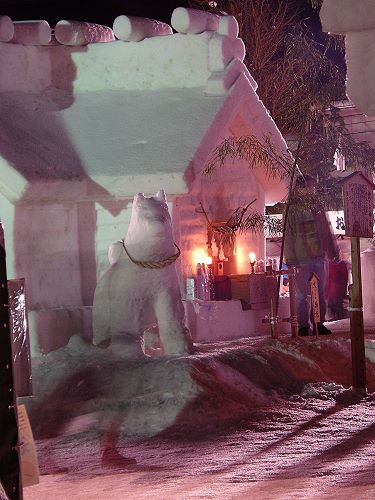
A giant snow dog stands as a guardian against thieves from the spirit world. By chance, it seems the camera even captured a ghostly thief in the foreground.
 A giant snow dog stands as a guardian against thieves from the spirit world. By chance, it seems the camera even captured a ghostly thief in the foreground. Here's another manhole cover, this time from Yuzawa. You can see Inukko Matsuri represented by the dog and shrine in the lower right corner.
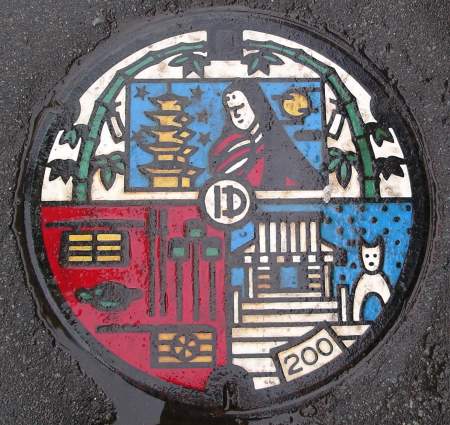 What could possibly say "Happy Valentine's Day" better than two cans of beer?
How about two cans of beer decorated with a ribbon and a rhinestone heart? 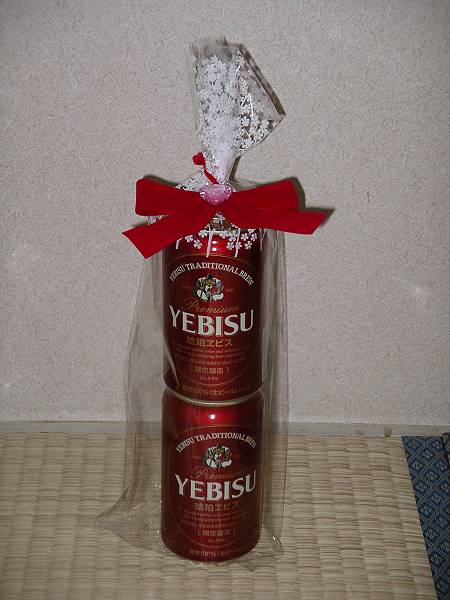 At Inukko Matsuri, we decided to enjoy some of the festival food for dinner. But what to have? Pretty much every food item available was something yaki - grilled or fried. There was takoyaki (octopus in fried balls of batter), yakiniku (grilled beef skewers), okonomiyaki (fried pancake with toppings), ikayaki (grilled squid), yakizakana (grilled fish), yakisoba (fried noodles) with or without medamayaki (fried egg), yakimochi (grilled mochi), yakitori (grilled chicken skewers), and yakidango (grilled rice flour balls). Other foods such as nabeyaki udon (fried noodle hot-pot), sukiyaki (simmered morsels), teriyaki (meat or chicken with a sweet sauce) and yakiimo (grilled sweet potato) were not represented at the festival.
As we considered our options, we saw a tent set off from the others a little ways, advertising dondoyaki. What kind of food might that be? We'd never heard of it, but thought it would be best to check it out before deciding what to eat. As we approached the tent, it became apparent that food was not involved. They actually seemed to be collecting pine branches. Then it dawned on us that yaki isn't just for food - it also means burning things. In fact, they were collecting new year's decorations to burn in a bonfire as part of a Shinto ceremony. 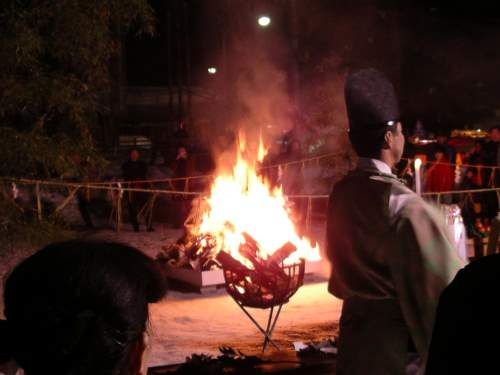 Needless to say, we opted for some of the other yakis for dinner. As a kid, I never fully understood Snoopy's paralyzing fear of the icicle over his doghouse. I saw plenty of icicles, and they just weren't big enough to kill a cartoon dog.
Now, I understand. I've had the experience of looking up to see a four-foot gleaming needle dangling above, ready to break free and plunge through my heart at the least provocation. On the bright side, I haven't actually seen any icicles breaking free unprovoked. But I do find myself checking above before walking under an eave. The four-footers are ubiquitous, but dwarfed by some eight-to-ten-foot icicles we spotted. You really don't want to be hanging out under these. 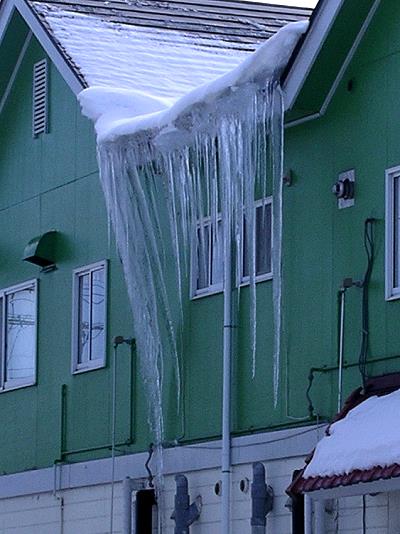 Meanwhile, the house across from ours has just the right roof slope, at just the right angle to the sun, to produce horizontal icicles: 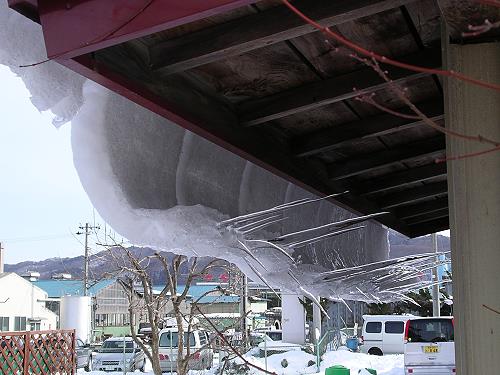 These are not actually dangerous, but they sure look like they're ready to fly off and perforate the building walls, don't they? Now if only I could get someone to use a pizza to entice me to safety... You can find almost anything your heart desires in vending machines in Japan: soda, beer, hot canned soup, 10-kilo bags of rice. . .
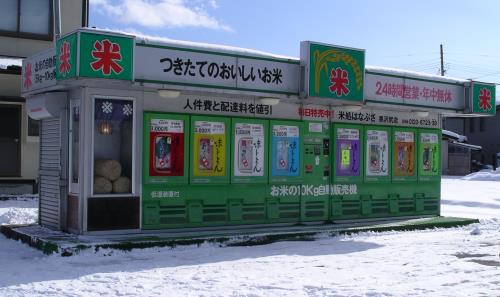 This machine has gotten some play before, courtesy of the late, great, Kitakami Photoblog (Konnichiwa, Julia-san!). New Year's in Japan seems to be an ongoing celebration throughout the month of January. Shinnenkai, or New Year's gatherings held after January 1, bring people together to share in the optimism of the fresh year ahead and to partake in traditional events. We were invited to one such event last week, mochitsuki.
As we've mentioned before, mochi is one of the traditional Japanese New Year's foods. Mochitsuki is the traditional mochi-making ceremony, during which members of the community use large wooden mallets to pound polished, cooked rice into a sticky paste. Once the paste is made, it is formed into small cakes, which can then be eaten. At the encouragement of our hosts, we took a turn kneading the mochi with the giant mallets. 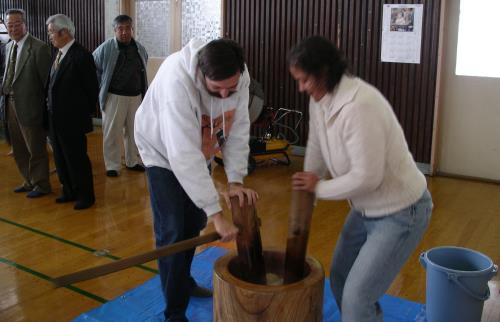 It was fun, but we clearly lacked the energy and expertise of the locals. 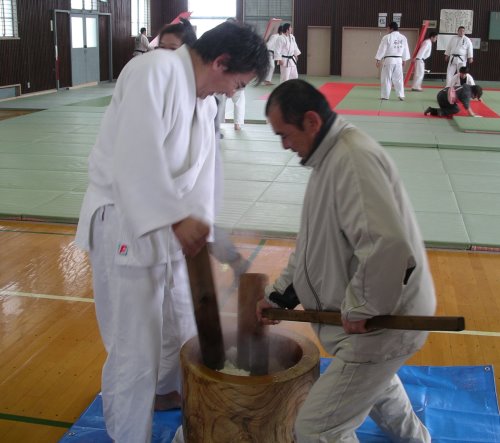 Once the kneading was completed, people alternated pounding the rice with a quick water rinse to keep it from sticking to the equipment. Children, assisted at times by their parents, got in on the pounding too. It was a great community event; one that we're glad we went out into the white-out conditions for. J-Life Lesson #46: When living in a part of the country where it snows every day during the winter, check frequently on your air-drying laundry.
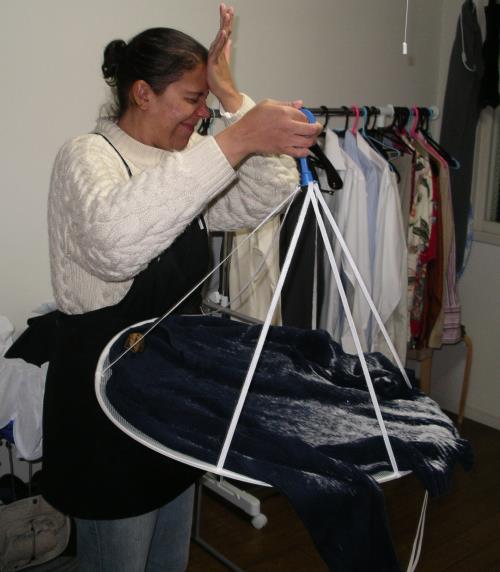 As longtime readers of the blog know, learning to cook Japanese food has been one of the great pleasures of my life here (eating the Japanese food has been Matthew's great pleasure). Last week, I got really ambitious and decided to make a standard ichiju-sansai dinner. Ichiju-sansai consists of soup and three small dishes, as well as steamed rice and tsukemono (pickles). These dishes come from families of foods named by their method of preparation, such as suimono (vinegared dishes), nimono (simmered dishes), and mushimono (steamed dishes). Each dish should come from a different family.
For our dinner, we had a nimono (kinpira gobou, simmered burdock root), an aemono (shira-ae, tofu dressing on vegetables and konnyaku), and sashimi (katsuo tataki, seared bonito) with ponzu sauce. The tsukemono were pickled carrots from my nuka-zuke bed. 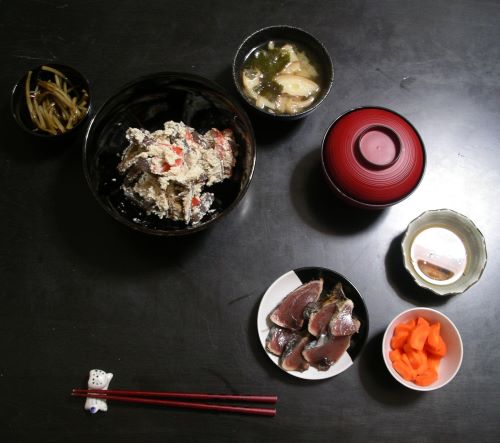 Making the dinner was pretty time-consuming, as was the cleanup. It was totally worth the effort. Back Next |